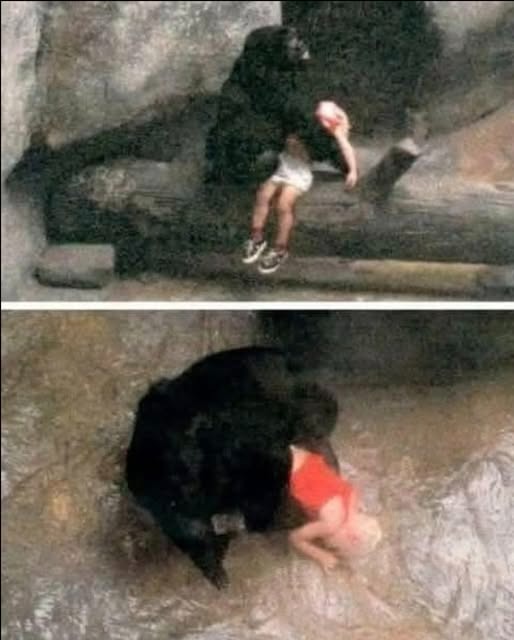On a warm summer afternoon in 1996, a small boy’s curiosity nearly turned into tragedy. At the Brookfield Zoo in Illinois, a 3-year-old child climbed a barrier surrounding the gorilla enclosure, only to slip and fall 25 feet to the hard ground below. Panic erupted instantly—screams filled the air, and chaos seemed inevitable. But in that moment of fear, a silent act of compassion would astonish everyone who witnessed it.
Among the seven western lowland gorillas in the enclosure, one stood out not for her size, but for her heart. Her name was Binti Jua, a 160-pound female gorilla who, in an act that seemed almost beyond belief, would become a symbol of empathy and instinctual care.

The Unlikely Hero
The story could have been easily dismissed as a fluke or coincidence if not for the footage captured by visitors. Binti Jua approached the unconscious child calmly, her movements deliberate and gentle. With her infant Koola clinging to her back, she cradled the boy in her arms, shielding him from potential harm. Onlookers watched in stunned silence as the gorilla scanned the area, seemingly aware of the danger posed by other gorillas nearby.
Zoo staff quickly intervened, using a hose to encourage the other gorillas to retreat, while Binti Jua carefully laid the child near the exhibit’s entrance. Paramedics reached him moments later. Though the boy had suffered a broken hand and a few bruises, he survived the fall—a miracle in no small part thanks to Binti Jua’s instincts.

Science Behind the Compassion
Stories like Binti Jua’s are rare, but not inexplicable. Primates, particularly gorillas, share striking similarities with humans in brain structure and social behavior. Scientific studies show that gorillas and other great apes are capable of empathy, understanding distress, and responding to it in ways that reflect social intelligence.
Researchers note that maternal instincts in gorillas are incredibly strong. A mother gorilla’s care for her own offspring can extend to other individuals in her group, especially vulnerable or distressed members. In Binti Jua’s case, her protective response to a human child highlights the possibility that these instincts can sometimes generalize beyond species.
Cultural Significance of Animal Guardians
Across cultures, stories of animals stepping in to protect humans appear in folklore, myth, and oral tradition. From guardian dogs in Celtic legends to elephants shielding humans in Southeast Asian stories, the idea of an animal protector resonates deeply. These tales often symbolize qualities such as loyalty, courage, and empathy—virtues that Binti Jua embodied without intent for recognition.
The public’s fascination with this story underscores a shared human appreciation for acts of kindness and moral reasoning. Binti Jua’s intervention became more than an isolated incident—it became a cultural touchstone for compassion that transcends species boundaries.
Lessons From Binti Jua
While Binti Jua’s story is remarkable, it also offers lessons about patience, observation, and understanding animal behavior. The incident shows that animals are capable of complex social reasoning, including assessing threats, protecting the vulnerable, and communicating intent through nonverbal cues.
For zookeepers and wildlife specialists, this event provided valuable insights. Careful attention to gorilla behavior, respect for their intelligence, and understanding their social instincts are crucial in ensuring safety for both humans and animals. It also underscores the importance of public education: observing animals in respectful ways can teach us about empathy, connection, and mutual care.
A Reflection on Human Curiosity
Humans have long been captivated by our interactions with the animal world. Binti Jua’s story reminds us that curiosity can lead to both danger and profound discovery. While a child’s curiosity placed him at risk, it also revealed an extraordinary act of instinctual kindness.
This story encourages reflection on our relationships with animals. In observing their behaviors, we see reflections of our own emotions, ethical reasoning, and capacity for care. It is a reminder that intelligence and compassion are not uniquely human traits—they exist in other creatures, waiting to be recognized and appreciated.

The Legacy of Binti Jua
Decades later, Binti Jua’s act continues to inspire. Videos of the rescue have circulated worldwide, and her story has been shared in classrooms, conservation centers, and social media feeds. She stands as a living example of the profound bonds that can exist across species, demonstrating that empathy is not bound by language, size, or species.
In a time when the world often seems divided, Binti Jua’s actions provide a unifying lesson: compassion is universal. It transcends species, circumstance, and expectation. Her legacy reminds us that even in moments of fear or uncertainty, kindness can emerge from the most unexpected places.
Conclusion
The tale of Binti Jua is more than a zoo anecdote—it is a reflection of the intelligence and emotional depth present in the animal kingdom. From her calm assessment of the situation to the careful way she cradled the child, Binti Jua demonstrated empathy, courage, and the quiet wisdom of a mother’s instinct.
Humans can learn much from her example. Observing her behavior encourages us to approach the world with patience, attentiveness, and an openness to compassion in all forms. Binti Jua reminds us that the lines between humans and animals are not as rigid as we often think. Acts of care, understanding, and empathy connect all living beings in subtle yet profound ways.
Her story endures as a testament to the unexpected heroes among us, and it continues to inspire generations to notice, nurture, and respect the capacity for kindness wherever it appears.
Sources
-
Goodall, J. (2000). In the Shadow of Man. Houghton Mifflin Harcourt.
-
de Waal, F. (2009). The Age of Empathy: Nature’s Lessons for a Kinder Society. Harmony.
-
Brookfield Zoo Archives: Rescue of Binti Jua, 1996.
-
Ross, S., & Lukas, K. (2006). “Gorilla Social Behavior and Maternal Instincts.” Primates Journal, 47(3), 231–239.
-
Mythology and Folklore of Animal Guardians. (2022). Encyclopedia of World Mythology.
